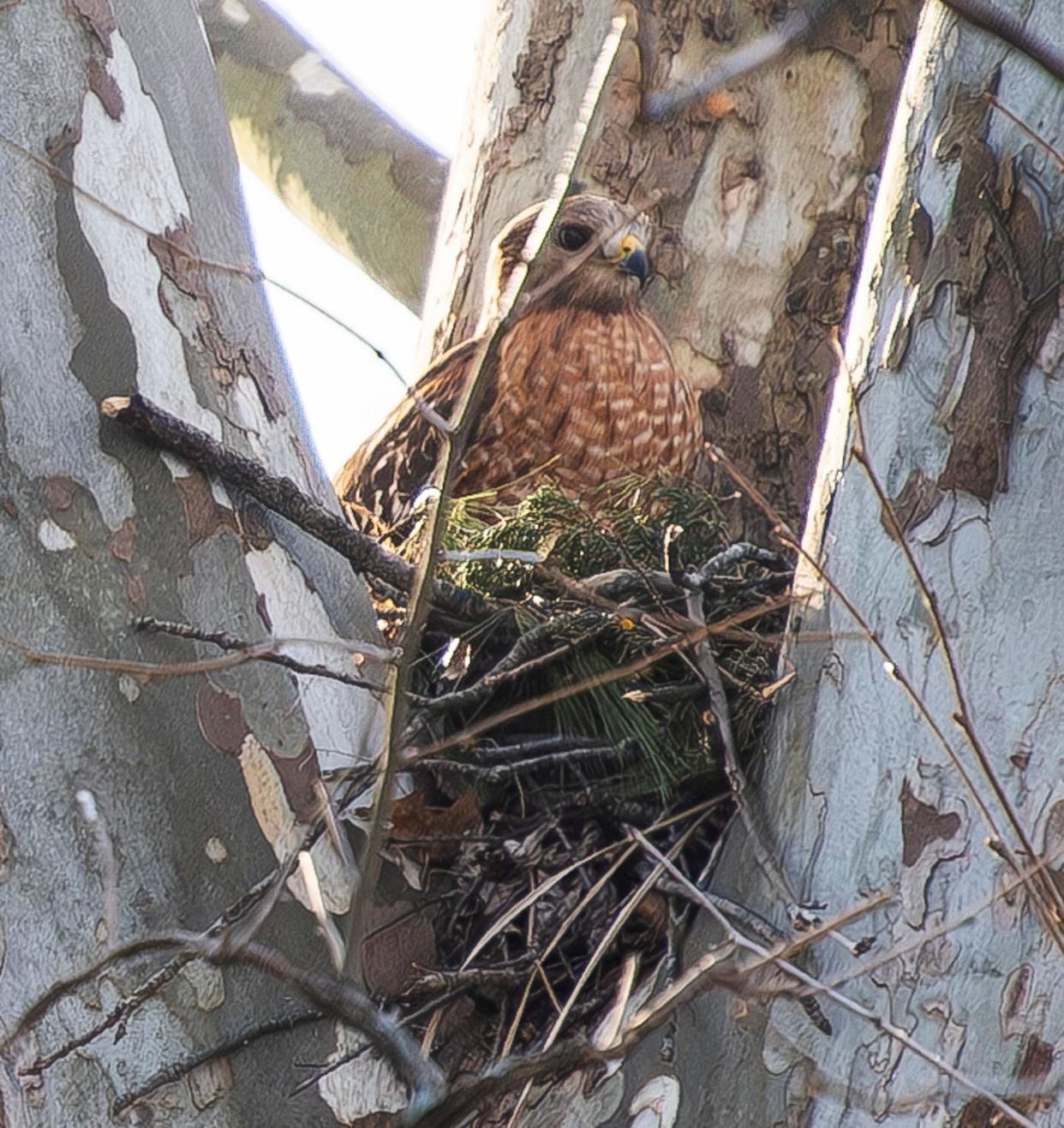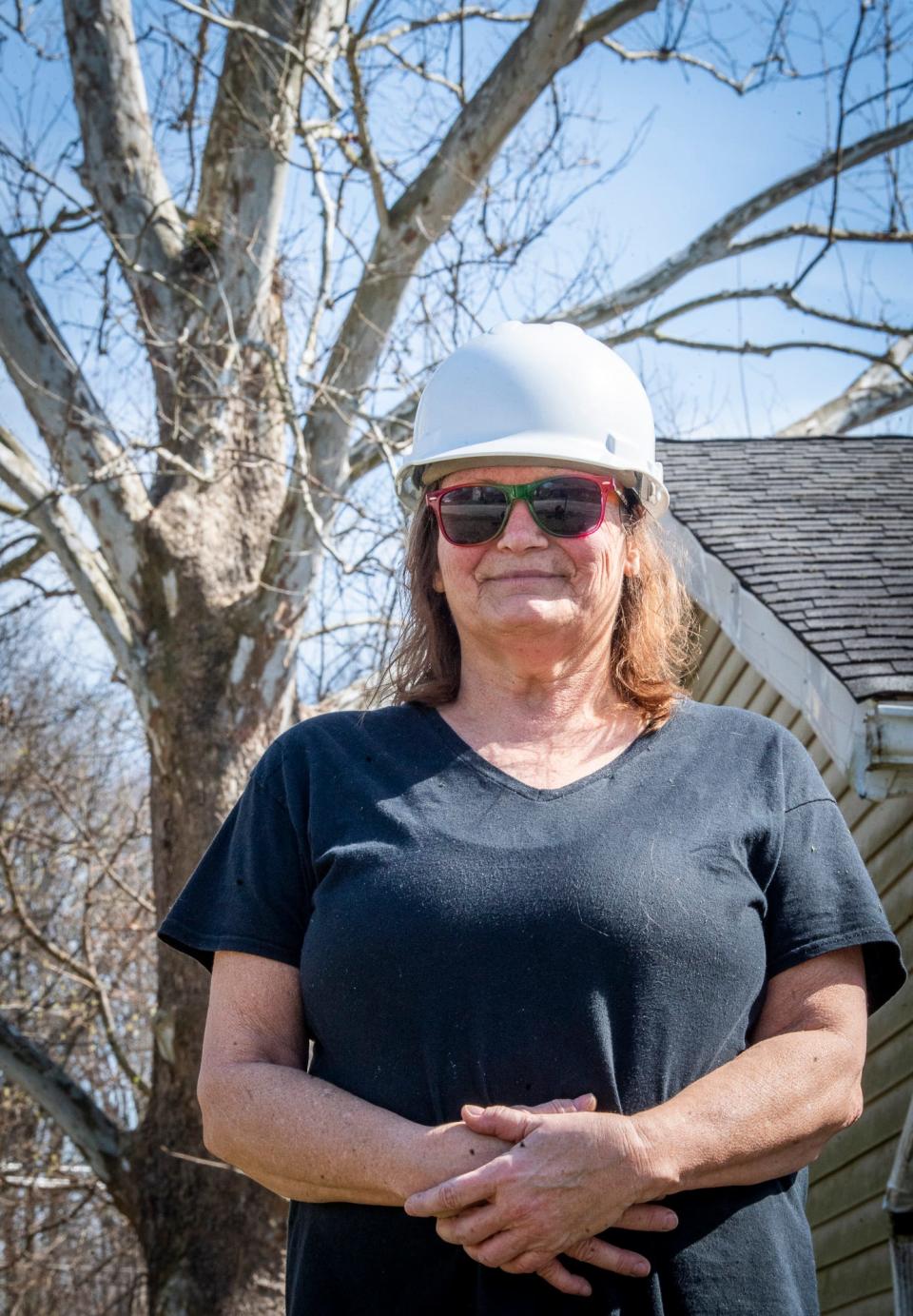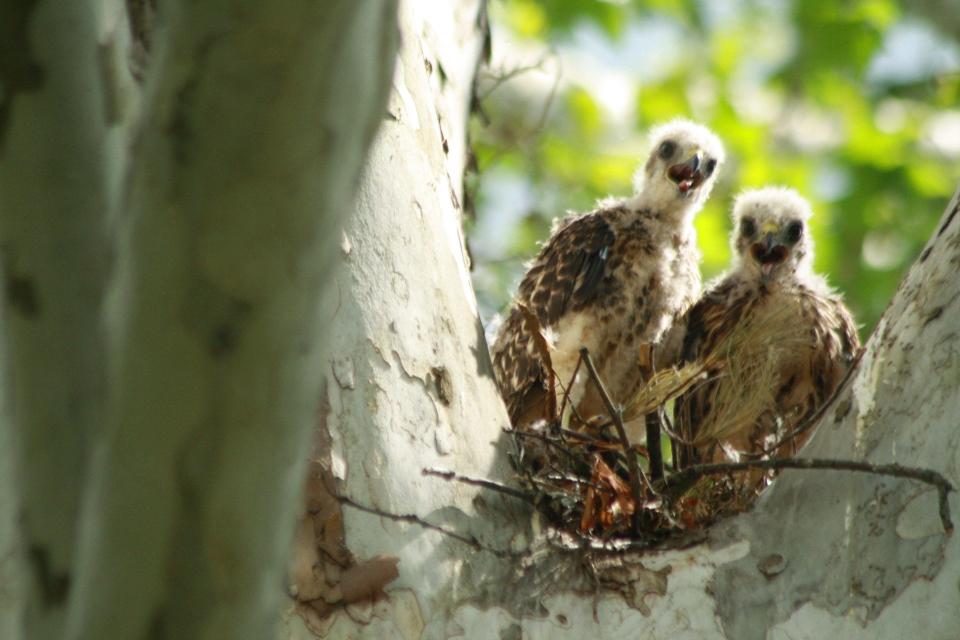Ellettsville woman is resigned to wearing a hard hat whenever she goes outside. Why?

ELLETTSVILLE — It was when she started wearing a DeWalt hard hat a friend delivered to her door that Angela Conner finally felt safe venturing outside her house.
There’s no construction in her quiet Ellettsville neighborhood, and no debris falling from the sky.
It’s a pair of overprotective, red-shouldered hawks which built a nest in a towering sycamore tree in her backyard that’s the problem. Conner and the birds are engaged in a territorial battle on the 64-year-old woman’s half-acre residential lot.
Conner has lived in the stone-front ranch house 30 years. No question; she was there first.
Still, it’s hard to argue with a bird of prey with a sharp beak and 3-foot-wingspan protecting its future offspring.
Seventeen times last spring, the hawks swooped down into Conner’s yard and attacked her head from behind, cutting her scalp with their talons and slamming their 1-pound bodies into her skull.

Blood gushed from head wounds. She sustained bruises from being hit. “It was pretty much every day for a while,” she said. “I had to wear this hard hat all year after I got it. For some reason, they don’t attack it.”
Until this past Thursday when the female, who squawked and flew off when an H-T photographer took pictures the previous day, descended and flew twice into Conner's helmet.
Hawks first appeared a year ago
In the spring of 2023, the male and female hawk built a nest of sticks in a flat spot where large branches meet in the center of Conner’s tall sycamore, about 30 feet up. Once their two eggs hatched in April, the parents were less combative and didn’t guard the nest as closely. They brought food for the hatchlings, called eyases, for five or six weeks, until they could fly and hunt on their own.
Come fall, Conner had an empty nest. All was quiet. She figured the hawk adventure was over.
... and they returned this month
Until a pair, which Conner figures are the original couple, came back this month. “They attacked me twice on Monday,” she said during a March 11 interview in her living room, safe from the hawks’ reach.
She placed the white plastic hard hat she used the previous year on the floor by her recliner, close at hand, ready to put on when she goes outside.
She’d rather not wear it while gardening, but does, for safety purposes. The strap presses into her chin and it’s uncomfortable while fertilizing strawberry plants, digging in perennial beds, pruning peach trees or turning cracked-in-half geodes toward the sun in her rock garden.
She spends a lot of time outside in the yard during spring and summer months. The hawks are often lurking overhead, closely monitoring the human below, as if they’re spying.
'Just go away': Attempt to remove nest falls short
These hawks may have reason to distrust Conner, who admits she wishes they “would just go away.” Sometimes she waves a garden rake toward the nest, cursing its adult occupants and wishing them gone.
Two weeks ago, she climbed a 20-foot-high extension ladder and swung at the nest with a 10-foot long limb trimmer, trying to dislodge it from the tree, to no avail. “I was about 5 feet shy of reaching it,” she said.
Sometimes she gives in, venturing onto the back deck to seek temporary shelter beneath a wide table umbrella.
Once the adults flew the nest last summer, Conner enjoyed watching the two tiny hawks grow and mature. She would zoom in as close as possible with her 35mm Canon, taking pictures of their fuzzy down feathers and huge eyes.

“I love the babies. They sat up there and watched me garden all summer,” Conner said. “I don’t want to do anything to jeopardize the eggs if they’ve been laid.”
She’s not happy about the hawks’ return to her property. St John’s Catholic Church is close by, with thick woods and towering trees that would offer many suitable locations for the hawks to build a nest. Why don’t they go over there, she wonders.
Instead, they’re back at Conner’s corner lot on Ridgewood Drive, not far from Ellettsville’s Jiffy Treet store and busy Ind. 46.
No money for nest removal
Conner said animal rescue organizations have suggested she hire a wildlife handler to relocate the nest to a more suitable nearby location. She got a $300 estimate from a company the animal shelter suggested. It's an expense she can’t afford.
“Then a guy called this morning, and he wants $300 to knock the nest down. He said he could come right out here,” Conner said. “But my car’s in the shop getting new brakes. I can’t spend my money on hawk removal.”
She did buy a fake plastic owl on eBay with a motion detector that causes the statue to hoot and its eyes to glow when something gets close. The hawks, unfazed, don’t give it a second look.
She attached a shiny aluminum roasting pan to a fencepost hoping the reflection would send the hawks flying. It hasn’t. She shakes a rake at them. They stare back at her.
Conner reaches for her hard hat, knowing it's probably too late to take down or move the nest this season. She may have another two months of this.
Federal law protects raptors
Wednesday morning the female hawk was perched on the nest and the male was flying angrily in the vicinity, Conner reported. Then next day, the hard-hat attack.
If the mother bird is laying eggs, it’s too late to tamper with the nest this spring. That’s the word from Allisyn-Marie Gillet, state ornithologist with the Indiana Department of Natural Resources’ Division of Fish & Wildlife.
Before eggs are laid, a nest can be dismantled or moved, Gillet said. But once eggs enter the picture, the Migratory Bird Treaty Act of 1918 comes into play, protecting not just migratory birds such as hawks, but also their nesting sites.
Gillet said red-shouldered hawks will return to the same nest year after year if it’s still intact. She said the time for Conner to take it down is in the fall after the baby hawks fly off for good.
She said interactions between humans and raptors are becoming more common as wildlife gets accustomed to humans in their midst.
“When red-shouldered hawks do begin to nest, some become aggressive toward anything that might threaten the nest, from people to raccoons, anything that might end up causing harm to the nest or the eggs and eventually the chick,” Gillet explained.
“They are more aggressive in spring, defending what’s in the nest. They spend a lot of time and energy in hatching the eggs and raising the chicks. They are really invested in them and will do whatever they have to do to protect them.”
Sometimes that means dive-bombing the woman who tends fruit and flower plants 30 feet below their nest of twigs and grass.
Gillet said time will solve the issue. She suggested Conner take the nest down once the baby birds leave and keep an eye out to make sure there’s no attempt to rebuild in the same sycamore tree.
She said Conner could use deterrents, like attaching a broom or something taller than she is to her body so the hawks will attack that. Or she can hook up a garden hose to an oscillating sprinkler that arches close to the nest.
She said hawks dislike water and might cease their attacks if a lawn sprinkler sent water toward the nest.
“They only attack,” Gillet said, “when they think they have an advantage.”
Contact H-T reporter Laura Lane at llane@heraldt.com or 812-318-5967.
This article originally appeared on The Herald-Times: Red shouldered hawk attacks prompt woman to wear a hard hat in yard

